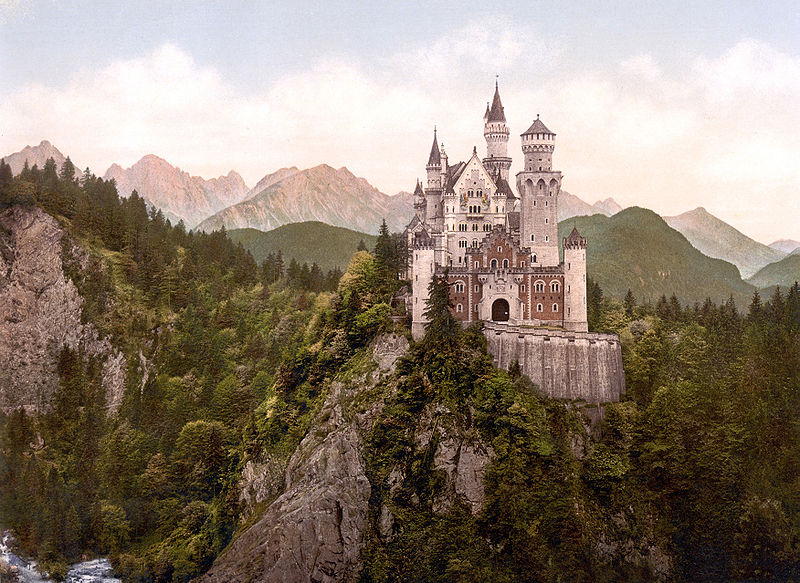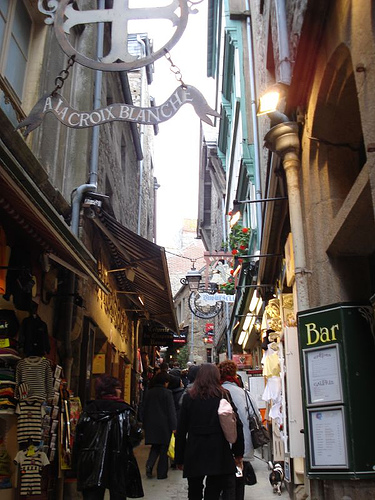We Can All Be Wizards
January 10, 2010
I keep my eye out for things that serve as an example of an alternative to Heroic Materialism, the aesthetic of the past two hundred years, corresponding with the Industrial Revolution. We are soooo ready for something new. Over time, I’ve collected bits and pieces of the overall picture. The carfree Traditional City is the centerpiece, whether a metropolis or a very small rural village. You have to live somewhere. But, that is only the beginning. Architecture, clothing, arts, cuisine, and all the other elements of culture come together to create a civilization.
November 22, 2009: What Comes After Heroic Materialism?
December 13, 2009: Life Without Cars: 2009 Edition
It is not so easy to take a picture of a civilization — how all these elements combine together to make a coherent whole of seamless fabulosity. However, I found a good example of what I mean: the Harry Potter movies.
In the Harry Potter world, there is the world of the “muggles,” or normal contemporary people, who generally live in Suburbia. And boy does it suck. Then, there is the world of the “wizards,” which is quite fabulous and fun. Oddly enough, there isn’t that much difference between “muggles” and “wizards” as people. Of course, the wizards can do magic, but so what. The main purpose of magic seems to be for doing battle with evil wizards. (Maybe there’s an appropriate comment about military technology to be made here.) While Harry Potter is in the muggle world (he has a foster muggle family, which is quite horrible), he lives a muggle lifestyle, although he himself is the King of the Wizards. Also, his friend Hermione has muggle parents as well (dentists). Wizards can only be wizards when they are in the world of wizards. Otherwise, they act like muggles even though they are actually wizards.
The world of the wizards is modeled after — late 19th century England.
The Harry Potter movies take place mostly at “Hogwarts,” a private boarding school located in a fantasy castle in Scotland.

This is a single castle, but let’s call it a “village” for now. It has a population comparable to a village, of a few hundred students, teachers and staff.
You can get around the “village” entirely on foot. It is a pedestrian environment –as are most all school campuses today.
March 3, 2009: Let’s Visit Some More Villages
You get to Hogwarts … on a train.
December 27, 2009: What a Real Train System Looks Like

The other urban environment seen in the movie is the wizards’ sector of London, which looks like this:

Does that look a little familiar?
Yes, it is our Really Narrow Street, with no cars of course. And the buildings are side by side.
It is full of people (“pedestrians”). Notice how well everyone is dressed.
October 18, 2009: Let’s Take Another Trip to Venice
The students at Hogwarts dress a little like suburban mall rats, but the adults are always in fine form.

I want to look like this when I’m 75.

Sharp!
And the interiors! Wow!

Nice office.

This is a bathroom.
When you’re a wizard, you piss in style.

Just a nice dinner.

The main dining room.

Notice that wizards eat real food. No factory chemical food for them!
If you’ve been paying attention this far, you probably noticed that the Harry Potter movies have all of the features that I’ve been talking about, starting first and foremost with the Traditional City (or village), and trains of course, and from that expanding to all the other parts that make up a proper civilization.
You notice that there are no cars in the land of the Wizards. No parking lots. No “green space.” No strip malls and fast food joints and big box crap. Everything looks fabulous. Everything is a Place. There is wilderness, but no non-Places.
October 10, 2009: Place and Non-Place
We in America are so unfamiliar with such things today, that we probably think that this is all a CGI fantasy. But, if you’re British, you probably know that this is all real, pretty much. These are real places. Made by real humans, the way humans made things before they were distracted by Heroic Materialism, especially the 20th century (automobile-centric) version.
This — fellow Americans — is our English heritage! A somewhat idealized version, to be sure. Not everything was sweetness and light and wizardly perfection in the later 19th century. But, we should be interested in their successes, not their failures or ongoing problems.
Could we do something like this? We did do something like this! This is the way we were supposed to live until we fucked it up.
Remember that stupendous bathroom?

The bathroom (really!) at Gloucester Cathedral, used as a set in the Harry Potter movies.

The Fort William to Mallaig service. This is the train in the Harry Potter movies, and yes it still runs.
Of course, we’d use an electric train today if we were going to get more serious about trains.
Many of the interiors are shot at Alnwick Castle, Northumberland.

The outer appearance of Hogwarts is a little fantastical, of course. Most castles are a little more practical.
Most.

Neuschwanstein castle, Bavaria. Completed in the 1880s. Certainly one of the most “fantastical” castles ever created out of heavy stone. Think of what would be possible today with steel construction.

Neuschwanstein from the side.

This hotel in Banff, Canada is somewhat Hogwarts-esqe.

Mont St. Michel, France is a fine “fantasy village.”
The main facade of the church was completed in the 12th century.

Actually, Gloucester Cathedral makes Hogwarts seem … a little mundane.

Recognize this hall? It’s Christ Church, Oxford.

Gloucester Cathedral. Many of the hallway shots in the Harry Potter movies were done here.

More from Gloucester Cathedral.

.Do you think that Dumbledore’s clothes are a little over the top?

El Greco’s portrait of St. Jerome, painted in 1590-1600.
The last thing I want to call your attention to is the non-urban areas. One characteristic of the wizards’ realm is that the wild places are really, really wild. Only a few hundred meters into the woods, and you’ll find all sorts of amazing creatures.
.
“Best not be going out there without a guide.”
In my wizards’ future, the wild places are once again really wild.
November 8, 2009: The Future Stinks
The oceans are full of fish. The woods are full of animals. The way they are supposed to be. The way they were before we fucked them up.
So we have cities (and very small cities, aka villages) that are really, really cities, and wild places that are really, really wild.
In short, pretty much everything I’ve been talking about is right there in the Harry Potter movies. This is more-or-less the way humans are supposed to live, the best of our best civilizations.

Shopping in Amsterdam. Wizards welcome.

Bavarian village.

Leadenhall market, London. Used to depict the area near the Leaky Cauldron and Diagon Alley in Harry Potter and the Philosopher’s Stone.
This market dates from the 14th century. The glass roof was added in 1881.

This London street was also apparently used in Harry Potter films as “Diagon Alley.”

More Leadenhall Market.

Leadenhall.


Is this Diagon Alley?
(Mont St. Michel, France)

Is this Diagon Alley?
(Venice)

How about this?
(Melbourne, Australia.)

Diagon Alley must be around here somewhere.
(Not even close. Chinatown, Victoria, British Columbia)

“Hagrid?”
(Mont St. Michel, France.)
Other comments in this series:
December 27, 2009: What a Real Train System Looks Like
December 13, 2009: Life Without Cars: 2009 Edition
November 22, 2009: What Comes After Heroic Materialism?
November 15, 2009: Let’s Kick Around Carfree.com
November 8, 2009: The Future Stinks
October 18, 2009: Let’s Take Another Trip to Venice
October 10, 2009: Place and Non-Place
September 28, 2009: Let’s Take a Trip to Barcelona
September 20, 2009: The Problem of Scarcity 2: It’s All In Your Head
September 13, 2009: The Problem of Scarcity
July 26, 2009: Let’s Take a Trip to an American Village 3: How the Suburbs Came to Be
July 19, 2009: Let’s Take a Trip to an American Village 2: Downtown
July 12, 2009: Let’s Take a Trip to an American Village
May 3, 2009: A Bazillion Windmills
April 19, 2009: Let’s Kick Around the “Sustainability” Types
March 3, 2009: Let’s Visit Some More Villages
February 15, 2009: Let’s Take a Trip to the French Village
February 1, 2009: Let’s Take a Trip to the English Village
January 25, 2009: How to Buy Gold on the Comex (scroll down)
January 4, 2009: Currency Management for Little Countries (scroll down)
December 28, 2008: Currencies are Causes, not Effects (scroll down)
December 21, 2008: Life Without Cars
August 10, 2008: Visions of Future Cities
July 20, 2008: The Traditional City vs. the “Radiant City”
December 2, 2007: Let’s Take a Trip to Tokyo
October 7, 2007: Let’s Take a Trip to Venice
June 17, 2007: Recipe for Florence
July 9, 2007: No Growth Economics
March 26, 2006: The Eco-Metropolis

